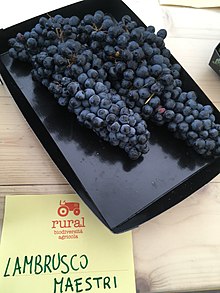Lambrusco
Lambrusco is a wine from the Italian region of Emilia-Romagna , Italy , made from the grape variety of the same name. There are many variations of this variety. It is also grown in Lombardy and in small quantities in South Tyrol . Lambrusco is also grown in small quantities in Argentina , where it is called Lambrusco Measini or Lambrusco Maestri .
The variety is very old, it is already mentioned by writers of Roman antiquity under the name Lambrusca .
Lambrusco, the sparkling red wine
Lambrusco is a sparkling, fruity red wine that is mainly produced in the area around Modena , Parma and Reggio nell'Emilia . The wines are made from a single variety of Lambrusco or have a small proportion of Ancellotta grapes to strengthen the color (because of its extremely dark red color, the grape variety Ancelotta is sometimes called Rossissimo ). The wines are made both dry (up to 15 g / l residual sugar) and sweet (approx. 40 to 50 g / l residual sugar) and exported in large quantities. A Lambrusco should be drunk young.
There are four DOC zones in which the wine is produced (as of 2015):
- Lambrusco di Sorbara , annual production approx. 102,000 hl, is mostly made from the Lambrusco di Sorbara grape variety. It is often dry and high in acidity. The area is north of Modena. The alcohol content is 10.5–12 % by volume , the total acidity is 7–9 g / l. The recommended drinking temperature is 14–15 ° C.
- Lambrusco Grasparossa di Castelvetro , annual production approx. 112,000 hl, is made from the Lambrusco Grasparossa grape variety. The wine is rich in tannins and has a residual sweetness. The area is south of Modena. The alcohol content is 10.5–11% by volume, the total acidity is 7–8 g / l. The recommended drinking temperature is 13-14 ° C.
- Lambrusco Reggiano , annual production approx. 156,000 hl. West of Modena is the most important area in terms of quantity. Different Lambrusco variants are used, most commonly the Lambrusco Salamino but also the Lambrusco Marani , Lambrusco Maestri and Lambrusco Montericco varieties . The Ancellotta variety is responsible for the dark color of most Reggiano wines. Some of the best manufacturers downgrade their Reggiano to Frizzante Rosso in order to implement their ideas of a good Lambrusco. The alcohol content is 10–11.5% by volume, the total acidity is 7–9 g / l. The recommended drinking temperature is 12-14 ° C.
- Lambrusco Salamino di Santa Croce , annual production approx. 183,000 hl. Most wines are very sweet and of poor quality. They are made to 90% from the Lambrusco Salamino grape variety. However, the few dry Lambruscos are excellent.
There is also the Lambrusco Mantovano region in Lombardy , which is located in the area on the Po south of Mantua and in which 315 wineries produce 36,341 hectoliters of Lambrusco in DOC quality. A Lambrusco dell'Emilia or Lambrusco dal Picòl Ross is also grown in the province of Reggio Emilia . This Lambrusco even has a certain storage capacity , but should also be enjoyed in the 18 months after sale.
Manufacture of Lambrusco
Making simple Lambrusco
The must is completely fermented and made into a dry Lambrusco still wine. This wine is temporarily stored at normal cellar temperature. As soon as a batch of Lambrusco is required, the still wine is conveyed to a pressure vessel together with unfermented must concentrate and pure yeast and this mixture is fermented at 2.5 bar until the desired residual sugar content is reached. The fermentation is interrupted by a cold shock and the wine is bottled.
- Advantage: cost-saving storage of the base wine
- Disadvantage: By completely fermenting the base wine, the freshness and aroma of the Lambrusco are lost.
Production of quality lambrusco
Immediately after the grapes have been pressed, the must is cooled to temperatures around 0 ° C and stored at this temperature. As soon as a batch of Lambruscow wine is required, the temperature of the required must is allowed to rise and pure yeast is added to it. As soon as the required residual sweetness is reached, fermentation is interrupted by means of a cold shock and the wine is filtered and bottled.
- Advantage: the freshness of the fruit and the aroma of the Lambrusco are retained
- Disadvantage: storing the must at 0 ° C is very expensive, and investments in technology are high.
As a middle ground one tries to mix the two techniques in order to combine the advantages of both methods.
literature
- Jancis Robinson : The Oxford Wine Lexicon, 3rd revised edition . Gräfe and Unzer Verlag, Munich 2007, ISBN 978-3-8338-0691-9 .
- Burton Anderson: Italy's Wines 2004/05 . Hallwag, Gräfe and Unzer, Munich 2004, ISBN 3-7742-6365-5 .
- Jacques Orhon: Le nouveau guide des vins d'Italie . Les editions de l'homme, Montreal 2007, ISBN 978-2-7619-2437-5 .
See also
Web links
Individual evidence
- ↑ 18 Lambrusco varieties are currently listed in the Vitis database , on vivc.de, accessed on May 7, 2017
- ↑ Viticulture in figures 2015. In: VQPRD d'Italia 2015. federdoc.com, accessed on August 1, 2016 (Italian).


